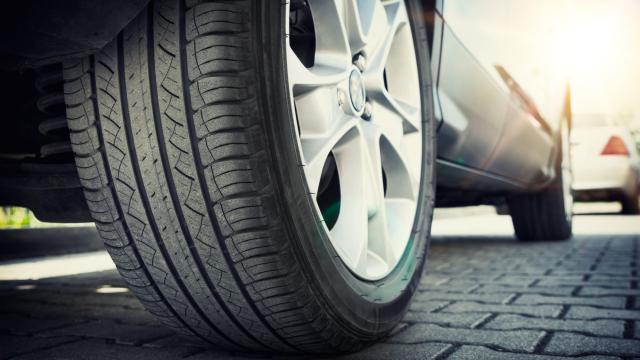Anyone who has ever had to face the sticker-shock associated with replacing a vehicle’s tire (or, worse, all of them) has probably wondered whether they could just opt for a used tired instead. Well, you can — but you probably shouldn’t. As Consumer Reports put it: “We say, ‘Nay, nay.’ Don’t buy used tires: You don’t know where they have been or how they’ve been used.”
Their biggest concern is safety: There’s no way to tell how unsafe a tire is likely to be, according to Consumer Reports, and that’s probably something you don’t want to mess around with. On the other hand, while new tires are superior to used ones in most ways, there’s one huge factor in favour of buying used tires: New tires are expensive. If you are considering putting a used tire on your vehicle, here are some things to think about before you shell out any money.
The pros and cons of new tires
Pros
- They’re safer: According to AAA’s research, driving on relatively worn tires at highway speeds in wet conditions can “increase average stopping distances by a staggering 43 per cent, or an additional 26.52 m.”
- They will last longer.
- You know exactly what you’re getting.
- It is usually easer to find the tires you need.
- The treads are even.
- They generally come with a warranty .
Cons
- They’re expensive: Due to supply chain issues, inflation (get it? because they’re tires?), labour unrest, and raw material cost, tire prices rose throughout 2021 and are expected to keep going up in 2022, in the U.S. at least.
The pros and cons of used tires
Pros
- They’re significantly cheaper — up to 50% less expensive.
- Environmental concerns: Scrap rubber is a big environmental issue, but I assume you’re going to recycle your old tires instead of tossing them by the side of the road. Still, there’s an argument to be made that driving every tire as long as it is safe to is the best choice for the environment.
Cons
- Lifespan: Unless it was never driven, the treads will be worn on a used tire and the rubber will be older, so it likely won’t last as long as a new tire of the same quality.
- Recalls: If a used tire is recalled, no one will tell you.
- The unknown: Even if you check the treads and tire very carefully for wear and damage, you can’t really know all the stresses that a tire had been put under by its previous owner.
- Limited (or no) warranty: While some sellers offer warranties on used pre-owned tires, they’re going to be much shorter than the four, five, or six-year warranties you can get for new tires.
What to check for if you are buying used tires
How long any car tire will last depends on so many factors — how the car is driven and maintained, the age and quality of the tire, road and weather conditions where the car was driven, whether you were doing doughnuts to impress your punk friends, etc. — that it’s impossible to reliably determine the point at which it makes monetary sense to buy a new vs. used tire. But that doesn’t mean it’s impossible to get a good deal.
Ask where the tire came from
There are reliable, inexpensive used tires out there. Lots of cars with perfectly good tires are totalled and sold for parts — just ask anyone who works at a salvage yard.
Check tread depth
How deep the treads are is the first thing you should consider when looking at a used tire. Tread depths are measured in 32nds of an inch, with new tires in the U.S. generally between 10/32” or 11/32”. While you can check tread depth with a coin, a tire-tread depth indicator costs less than four bucks and will give you an accurate measurement. For an idea of how low is too low, dealerships consider anything under 4/32nds too low to trade in a vehicle without getting new tires put on. Anything lower than that, and things get dangerous.
Check the tire’s age
Even if the treads are deep, it’s a bad idea to buy an old tire. Rubber dries and weakens over time, even if you barely drive at all. While there’s no definite lifespan of a tire, Chrysler, Ford General Motors, and European car manufacturers put tire shelf-life at six years.
Damage
Give the tire a thorough inspection. Check the seams for splitting. Check for any signs of patches or repairs. Check for cracks. Check for bubbles in the sidewall. Check for any dings, missing chunks, and flat spots. Check for uneven wear: If the last driver had bad alignment, or over/under-inflated his tires, don’t buy ‘em. This YouTube video provides an extra in-depth look at inspecting a tires with helpful visuals so you know what to look for. But understand: You might not be able to see a tire defect at all.
Price
Make sure you check the price of a new tire new before you buy a used one to see if the savings are worth it.
The one time it’s always a good idea to buy used tires
If you lease a car, you are usually required to return it with tires treads at 4/32 or above. If your tires are below that level or otherwise damaged, put on used tires instead of new ones right before your lease is up — dealers charge a ton to replace tires after-the-fact. Just make sure the used tires are the same size and specifications as the original equipment, and check your lease for any other details or limitations — some leases require specific tire brands, other don’t.

Leave a Reply
You must be logged in to post a comment.